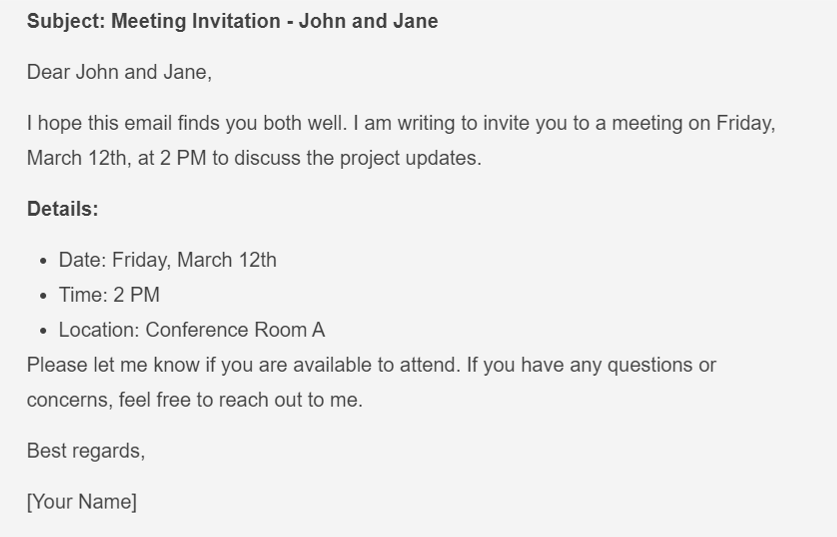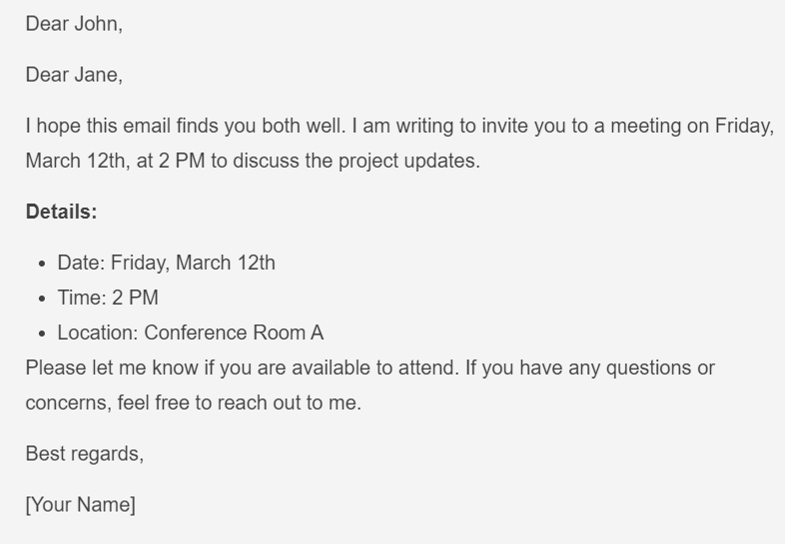You’ve got an email to write, but this time, it’s not just for one person. You need to address two people. And suddenly, you’re stuck.
How do you greet them? Should you use their first names or titles? What if you know one person better than the other?
Sending an email to multiple people doesn’t have to be a daunting task. In fact, with a few simple tips and tricks, you can easily navigate the world of group emails.
Whether it’s a professional email to colleagues or a fun message to friends, this post will show you how to address two people in an email like a boss.
So, let’s get started and make sure your next email to multiple people hits the mark.
Table Of Contents:
- How to Address Two People in an Email
- Best Practices for Emailing Multiple Recipients
- Examples of How to Address Two People in an Email
- Tips for Sending Emails to Multiple Recipients
- FAQs: How to Address Two People in an Email
- Conclusion
How to Address Two People in an Email
You’ve got an email to send and you need to loop in a couple of folks. And now you’re wondering, how do I address multiple people in an email the right way?
Let’s break it down step by step.
Step 1: Determine The Relationship
First things first, think about the relationship between the people you’re emailing.
Are they colleagues, clients, or maybe a mix of both? The level of formality in your greeting should match the type of relationship.
For example, if you’re emailing two clients, keep it professional with something like “Dear Mr. Johnson and Ms. Smith.”
But if it’s two coworkers you’re friendly with, feel free to loosen up a bit with “Hi John and Sarah.”
Step 2: Use Proper Salutations
When it comes to email etiquette for multiple recipients, using the right salutation is key. You want to address multiple people in a way that’s respectful and inclusive.
My go-to formula? Use both names in the salutation, followed by a comma.
Like this: “Dear John, Sarah,” or “Good morning, Mike and Lisa.”
Simple, yet effective.
Step 3: Be Clear What You Want From Who
Now that you’ve nailed the greeting, it’s time to think about the email body itself. When you’re addressing multiple people in an email, clarity is your friend.
Make sure you’re crystal clear about what you need from each recipient. If there are action items, deadlines, or questions, spell them out for each person individually. This helps avoid confusion and keeps everyone on the same page.
A well-crafted, personalized greeting is the key to kicking off your message on the right foot. Invest a little time in perfecting your introduction, and watch your email correspondences flourish.
Best Practices for Emailing Multiple Recipients
Emailing multiple recipients comes with its own set of email etiquette rules. Let’s explore the best practices for addressing a group email, so you can confidently communicate with your team and colleagues.
Use the CC and BCC Fields Properly
When you’re writing business emails to multiple recipients, the CC (carbon copy) and BCC (blind carbon copy) fields are your best friends.
Use CC when you want everyone to see who else received the email. This is great for keeping people in the loop or assigning group tasks.
If you want to send an email to multiple recipients but want to protect people’s privacy, use the BCC field. When you add email addresses to the BCC field, recipients can’t see who else got the email. This is perfect for sending out email marketing newsletters.

Avoid Generic Greetings
When it comes to addressing multiple people in an email, generic greetings like “Hey everyone” or “To whom it may concern” just don’t cut it. They feel impersonal and can make your recipients feel like an afterthought.
Instead, take the time to address your recipients by name. If it’s a smaller group, you can list out each name in the greeting. For larger groups, try something like “Dear team” or “Hello everyone.”
Maintain a Consistent Tone
Want to make a great impression with your email? One simple trick is to keep the recipients’ names consistent throughout.
If you kick things off with “Dear John and Sarah,” maintain that same format until the very end.
Consistency is key – it demonstrates your attention to detail and respect for the people you’re addressing.
And if you’re wondering whether to use first names, last names, or titles, take your cue from the relationship. Stick with titles and last names for formal situations, and first names for more casual correspondence.
Proper email etiquette also means being consistent in your tone and style throughout the entire email. If you start with a formal greeting, keep the rest of the email professional and polished.
The same goes for your sign-off. If you open with “Dear colleagues,” don’t close with “Catch ya later.”
Consistency helps your email feel cohesive and well-crafted.
Proofread Before Sending
Before you hit that send button, take a moment to proofread your email. Double-check that you’ve spelled everyone’s names correctly and included all the necessary email addresses.
A quick once-over can also help you catch any typos, grammatical errors, or unclear phrasing. Trust me, taking the extra minute to proofread can save you from some embarrassing email blunders.
Examples of How to Address Two People in an Email
You’re about to send an email to two people, and you’re not quite sure how to address them. Here are some examples of how to start your email.
Formal Business Email Greetings
When you’re sending a formal business email to two people, it’s important to use proper salutations and titles. Here are some examples that have worked well for me:
- “Dear Mr. Johnson and Ms. Thompson,”
- “Good morning, Dr. Patel and Professor Davis,”
- “Greetings, Director Brown and Manager Lee,”
When I address multiple seniors or authority figures, I always make a point to include each person’s name and title in the greeting. It’s a simple gesture that demonstrates respect and ensures everyone feels recognized.
Informal Email Greetings
When you’re writing to two friends or close colleagues, you can be a bit more casual with your greetings. Here are some examples that I like to use:
- “Hi John and Diana,”
- “Hey Justin and Steve,”
- “Good day, Tom and Kate,”
I find that using first names and friendly greetings like “Hi” or “Hey” sets a warm, personal tone. It’s the email equivalent of walking into a room and saying, “Hey, good to see you both.“
Just remember to keep the overall tone respectful and appropriate for your relationship with the recipients.
If you need to write an email fast, an AI tool can help you get the job done. BrandWell‘s AIMEE chatbot suggests two ways to address multiple people in an email.
One is to address both persons:

An alternative way is to address each person individually:

Email greetings are your chance to set the tone for your entire message. By tailoring your salutation to your audience and the relationship you have with them, you’ll create an immediate connection that will keep them reading and responding.
Tips for Sending Emails to Multiple Recipients
Sending emails to multiple recipients can be tricky, but I’ve got a few tips that have helped me keep my messages on point. By following these strategies, you can craft emails that are clear, concise, and free of any embarrassing mistakes.
Clarify Who You Are Addressing
I like to use the “@” symbol to allocate tasks or questions to each person.
For example:
@John, could you please review the attached report and let me know your thoughts?
@Mary, I’d appreciate it if you could schedule a meeting for us to discuss the findings.
I’ve found that this approach keeps things clear and actionable, while still maintaining a friendly, collaborative tone. It’s like saying, “We’re all in this together, and here’s what I need from each of you.“
Keep the Email Concise and to the Point
When you’re emailing two or more people, it’s important to keep your message concise and focused. People are busy and don’t want to read through long, rambling emails. So make a conscious effort to stick to the main points and be clear about any actions needed.
For example, instead of writing a lengthy paragraph about a project update, I might say something like:
“Just wanted to let you both know that the design phase of the project is complete. @John, could you please review the mockups and provide feedback by Friday? @Katie, once we have John’s input, let’s schedule a meeting to discuss the next steps.”
Want to keep multiple recipients engaged? Be brief, be bright, and be gone. That’s the secret sauce for getting responses and holding attention.
Use Bullet Points for Lengthy Information
If you do need to include a lot of information in your email, consider using bullet points to break it up. I’ve found that this makes the content much easier to read and reference, especially when I’m sending emails to multiple recipients.
For example:
- Project Overview
- Key objectives
- Timeline
- Budget
- Action Items
- @John: Review designs by 6/1
- @Sarah: Schedule team meeting by 6/5
- @Mike: Prepare project budget by 6/10
See how much easier that is to digest than a wall of text? Bullet points are your friend when it comes to multi-recipient emails.
Double-Check Recipients’ Email Addresses
Before hitting “send” on any email, but especially one with multiple recipients, always double-check that you’ve entered the email addresses correctly.
I can’t tell you how many times I’ve accidentally sent an email to the wrong “John” or “Steve” because I was in a rush. Take that extra moment to confirm the addresses and avoid any embarrassing mix-ups.
Include Relevant Contact Details
Before you hit send on that email, take a second to make sure your signature has all your contact details, especially when you’re reaching out to people outside your organization.
In mine, I’ve got my full name, my role at the company, and my phone number – it’s a quick way to show I’m available and happy to connect.
Sure, it’s a minor thing, but it lets people know you’re a pro who’s easy to get in touch with.

Source: Tidio
FAQs: How to Address Two People in an Email
How do you write an email to multiple recipients?
To write an email to multiple people, address them all at the start. Use “Dear” followed by names or titles, separating each with a comma.
How do you refer to two people with the same name in an email?
Add their last initial after their first name. If they share that too, use full last names.
How do I address colleagues in an email?
Use “Hi” or “Hello,” followed by their first names if it’s casual.
For formal tones, go with “Dear.”
Is it okay to say “Hi both” in an email?
“Hi both” works for informal emails but choose more formal greetings when the context demands seriousness.
Conclusion
And there you have it – your complete guide on how to address two people in an email. Whether you’re writing a formal business email or a casual message to friends, you now know how to greet multiple recipients with confidence.
To craft the perfect email, think about your connection with the recipient and why you’re reaching out. Use their name consistently throughout, and open with a friendly greeting that sets the right tone. Keep your message on point, but let your unique voice shine through.
Stay one step ahead with WorkMind’s blogs, crafted to deliver real results for students and professionals. See what we have in store for you.